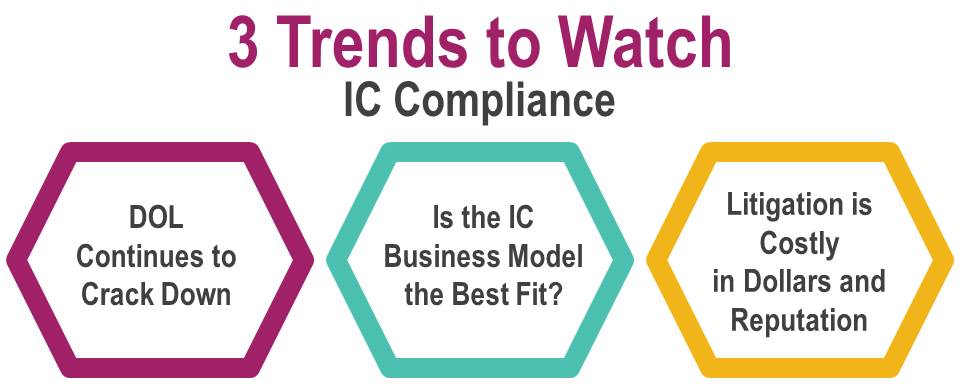
The first quarter of 2016 is in the books and the topic of Independent Contractor Compliance is hotter than ever. Here are three of the key trends we’ve been keeping track of so far this year:
1. The Department of Labor Continues to Crack Down
In 2016 the Wage and Hour Division will continue to coordinate with other federal and state agencies to identify misclassified workers and to recover lost wages and benefits.
Recently, Dr. David Weill of the DOL’s Wage and Hour Division reaffirmed his department’s focus on worker misclassification. Weill specifically identified the home health care industry as an area where their enforcement efforts will be concentrated.
Reports have stated that the Obama administration’s 2017 budget proposal for Wage and Hour will seek an increase to $277 Million for the division, which includes $10 Million to continue grants to states to enhance efforts to curb worker misclassification.
Secretary of Labor Thomas Perez announced that he will rerun the Contingent Worker Supplement to the Bureau of Labor Statistic’s Current Population Survey. This is a renewed attempt by the DOL to obtain better and more accurate data regarding the number of workers who are employed in other than full-time or traditional employer-employee arrangements.
The survey will include:
- Workers who are in the “on demand” economy
- People who identify as self-employed
- Agency temps
- Direct hire temps
- On-call workers
- Day laborers, and
- Standard part-time workers
This additional data has not been gathered since 2005, so this announcement represents a renewed commitment by the DOL to obtain current data for purposes of making policy decisions and allocating agency resources.
Secretary Perez stated the survey “will help the department do something that is essential to smart policymaking and smart business: understanding the past and the present so that we can prepare for the future.
2. Is an Independent Contractor Model the Best Fit for My Business?
Many firms are discovering that the independent contractor model is not the best fit for their business and are changing to a traditional employer-employee model for a few reasons:
- The need to provide better customer service
- To have an engaged workforce that is invested in the long term success of their business
An example from within the Sharing Economy:
Home Health Care News reported in January that home care startup Honor is changing its business model from an independent contractor model to an employee model. Honor joins several fellow startups that have transitioned away from the independent contractor model, including Muncherie, Shyp, Eden, Luxe and Sprig. The article cited Honor’s need to provide their workers with stability and upward mobility as driving factors in making this change.
3. Litigation is Costly – Both in Dollars and Reputation
High profile litigation can be damaging both in terms of litigation costs and costs to a company’s reputation. As the labor market continues its recovery and becomes increasingly competitive on the employer side, companies can no longer ignore the tangible and intangible costs of misclassification. Some recent cases making headlines:
- Pepperidge Farm has been named as a plaintiff in a class action suit filed by its Sales Development Associates (SDAs). SDAs are the workers who deliver, set up, and maintain Pepperidge Farm products in supermarkets. The suit was filed in the Northern District Court of Illinois as a class action and alleges that the workers routinely worked long hours and were improperly classified as independent contractors. The case is docketed as Mulhern vs Pepperidge Farm, case no 16-CV-02199 (N.D. IL).
- Recently Lyft attempted to reach a settlement with its drivers for $12.5 Million. The proposed settlement provides for the drivers to agree that they are independent contractors, preserving Lyft’s current business model. In return, Lyft would agree to notify drivers in the event of deactivation, provide a “favorite driver” feature, and agree to cover certain arbitration costs in the event of driver deactivation, ride fees or other employment-related issues. The settlement is facing tough scrutiny by Judge Vince Chhabriawho has requested briefings by both parties before he will approve or reject the settlement. The case is Cotter v. Lyft, Inc., No. 3:13-cv-04065-VC (N.D. Cal.)
- Amazon suffered an avalanche of bad press after four of its Prime Now drivers filed a class action suit in California alleging they were improperly misclassified as independent contractors. The drivers were employed via a third party agency that treated them as independent contractors. In an article posted February 29th, Buzzfeed reported Amazon directed its subcontractor, Scoobeez, to reclassify the drivers as employees.
Employers who are not certain of a worker’s proper classification as an independent contractor should always seek the advice of their legal or tax professional.



 Donna Morris
Donna Morris Populus Group
Populus Group.png) Brandon Byrd
Brandon Byrd
Leave a comment